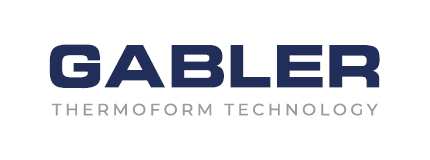The next generation of the trim-in-place machines also boasts convincing increased output.
Producing cups with post-trim (PT) or trim-in-place (TIP) processes? Both methods have their advantages. Up to now, post-trim was chiefly out in front as far as output capacity was concerned. The new generation of trim-in-place machines, however, is now set to overtake. A new age of tilt-bed technology now seems to be dawning with an increased output of up to 50 per cent. The M100 from GABLER Thermoform, for instance, reaches an output rate of up to 180,000 standard cups per hour.
“Our customers, mainly in the USA, have frequently told us that they would like to take advantage of the TIP benefits if only output were higher. The new generation of our TIP machines grants this wish,” Peter Grolla, Managing Director of GABLER Thermoform, says.
Lots of benefits with TIP technology
As is well known, forming and cutting involve just one step with trim-in-place technology. In contrast to post-trim, freely suspended cup-foil rolls and rapid-tact punching and stacking processes do not occur. Production with trim-in-place is consequently extremely precise. The process scores with effective tact operation and continual high production performance with constant quality. In addition, the material input this method utilises is impressive and far lower, as TIP is able to distribute the material more optimally.
Confirmed product quality with stable, exactly customised and lighter cups
In terms of product quality, cups formed in the trim-in-place machines are generally a step ahead. They are precisely shaped, extremely stable, a perfect fit and of best top-loading stability. Here, the highlight: as the product quality increased, the weight decreased at the same time, meaning a TIP cup tips the scales at just 3 grams instead of 4 grams. “The scope for economising on material frequently amounts to around 10 to 20 per cent”, Carsten Stöver, Sales Manager at GABLER Thermoform, adds.
In this respect, this shows that not just quantity counts in thermoforming. The demand is for high-quality products to guarantee smooth processing at later stages and a satisfactory final result. The new trim-in-place generation even features the high polypropylene shrink factor of 1.85 per cent to enable the production of immaculate cups.
Reduction of personnel costs and compensating for staff shortage
Does not a machine with such a high output require more staff to handle the vast quantity of cups produced? Quite the opposite. The cups are automatically stacked accurately, and directly enter the flow wrapper to be packed in the cartoner.
“Production with the new TIP models reduces personnel costs,” also comments Gary Sowden, Sales Director for North America at GABLER Thermoform. “Whereas 5 to 6 persons are required for the post-trim process, just 2 people are needed to handle the products in the trim-in-place process. This is an ideal answer to the critical shortage of staff, particularly in the USA.”
TIP news at NPE 2018 in Florida
Visit NPE 2018 in Florida to see the next generation of trim-in-place machines at first hand. GABLER Thermoform will be presenting its TIP flagship there: the M100.
Find more about attending the fair here or obtain detailed information about the M100!

